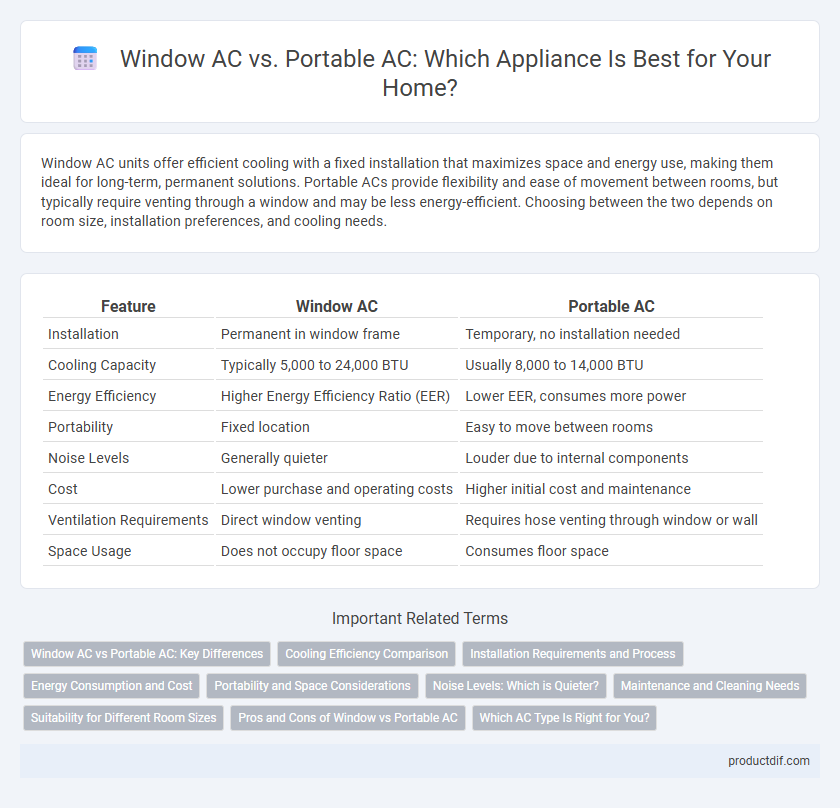Window AC units offer efficient cooling with a fixed installation that maximizes space and energy use, making them ideal for long-term, permanent solutions. Portable ACs provide flexibility and ease of movement between rooms, but typically require venting through a window and may be less energy-efficient. Choosing between the two depends on room size, installation preferences, and cooling needs.
Table of Comparison
| Feature | Window AC | Portable AC |
|---|---|---|
| Installation | Permanent in window frame | Temporary, no installation needed |
| Cooling Capacity | Typically 5,000 to 24,000 BTU | Usually 8,000 to 14,000 BTU |
| Energy Efficiency | Higher Energy Efficiency Ratio (EER) | Lower EER, consumes more power |
| Portability | Fixed location | Easy to move between rooms |
| Noise Levels | Generally quieter | Louder due to internal components |
| Cost | Lower purchase and operating costs | Higher initial cost and maintenance |
| Ventilation Requirements | Direct window venting | Requires hose venting through window or wall |
| Space Usage | Does not occupy floor space | Consumes floor space |
Window AC vs Portable AC: Key Differences
Window AC units offer a permanent cooling solution with higher energy efficiency and better cooling capacity, ideal for single rooms or small spaces. Portable ACs provide flexibility and ease of installation, making them suitable for renters or temporary cooling needs but typically consume more electricity and produce more noise. The choice between window and portable AC units depends on factors such as space size, installation preferences, and energy consumption priorities.
Cooling Efficiency Comparison
Window air conditioners generally offer higher cooling efficiency due to their direct ventilation design, which allows better heat expulsion and more consistent temperature control. Portable air conditioners typically have lower SEER (Seasonal Energy Efficiency Ratio) ratings, as they exhaust hot air through a hose, causing some heat to remain in the room and reducing overall performance. Energy consumption metrics often show window AC units consuming less power for the same cooling output compared to portable models, making them more cost-effective in long-term use.
Installation Requirements and Process
Window AC units require mounting within a window frame, demanding secure support and sealing to prevent air leaks, often needing professional installation for optimal performance. Portable ACs feature flexible venting hoses that can be set up near any window or sliding door with a venting kit, making the installation process simpler and more versatile without permanent fixtures. Both require proper sealing and drainage solutions to ensure efficiency, but window ACs typically involve more complex installation steps and potential structural modifications.
Energy Consumption and Cost
Window air conditioners generally consume less energy compared to portable AC units, making them more cost-effective for cooling small to medium-sized spaces. The higher energy efficiency of window ACs results in lower electricity bills over time, while portable ACs, which require more power to circulate air and remove heat, tend to increase energy consumption and operational costs. Initial purchase prices for window units are often lower, but portable ACs offer flexibility despite higher ongoing energy expenses.
Portability and Space Considerations
Portable AC units offer greater flexibility due to their lightweight design and built-in caster wheels, allowing easy relocation between rooms without permanent installation. Unlike window ACs, which require fixed positioning and a dedicated window space, portable ACs save room by eliminating bulky window mounts, making them ideal for small apartments or spaces lacking suitable window access. Their compact footprint and versatility accommodate dynamic living environments while optimizing spatial efficiency.
Noise Levels: Which is Quieter?
Window air conditioners typically operate with noise levels ranging from 50 to 60 decibels, making them moderately quiet for continuous use. Portable air conditioners often generate more noise, averaging between 55 and 65 decibels due to the internal condenser and exhaust fan placement inside the room. For a quieter environment, a window AC is generally preferred as it dissipates heat and sound outside.
Maintenance and Cleaning Needs
Window AC units require regular cleaning of filters and coils to maintain airflow and efficiency, typically needing less frequent full maintenance due to their fixed installation. Portable ACs demand more frequent filter cleaning and drainage of water tanks, with increased risk of mold buildup if not properly maintained. Both types benefit from scheduled inspections, but portable units generally require more hands-on upkeep due to their mobility and internal water collection.
Suitability for Different Room Sizes
Window AC units are ideal for cooling medium to large rooms, offering efficient airflow and consistent temperature control by being installed directly in a window or wall. Portable ACs provide flexibility for smaller spaces and temporary use, but typically have lower cooling capacity and can be less efficient for large rooms. Room size and installation preferences dictate whether a window or portable AC is better suited for effective climate management.
Pros and Cons of Window vs Portable AC
Window AC units offer superior energy efficiency and cooling power compared to portable ACs, making them ideal for larger rooms or prolonged use, but they require permanent installation and block window views. Portable ACs provide flexibility and ease of installation, allowing movement between rooms, but tend to be less efficient, noisier, and may require venting through a window or wall. Choosing between window and portable AC depends on room size, mobility needs, installation constraints, and budget considerations.
Which AC Type Is Right for You?
Choosing between a window AC and a portable AC depends on room size, installation flexibility, and noise levels. Window AC units offer higher energy efficiency and cooling capacity for fixed window spaces, while portable ACs provide ease of movement and require minimal installation. Consider your room layout, insulation, and mobility needs to determine the best option for optimal comfort and energy use.
Window AC vs Portable AC Infographic

 productdif.com
productdif.com